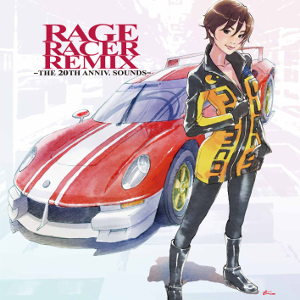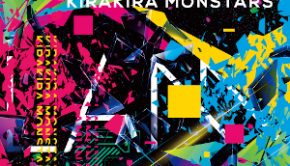RAGE RACER REMIX -THE 20TH ANNIV. SOUNDS-
 |
Album Title: RAGE RACER REMIX -THE 20TH ANNIV. SOUNDS- |
| Record Label: Sweep Record |
|
| Catalog No.: SRNS-2002 |
|
| Release Date: July 27, 2017 |
|
| Purchase: Buy at CD Japan |
Overview
To celebrate Rage Racer’s 20th anniversary, the RAGE RACER REMIX -THE 20TH ANNIV. SOUNDS- album was created and is spread over two discs. The first disc features “Reactive Remixes,” featuring remixes from Supersweep members, current and former Bandai Namco composers, and some guest arrangers. while the second disc contains the “Remind Remixes,” which stay much closer to the original soundtrack, composed by Hiroshi Okubo and Tetsukazu Nakanishi, with touch-ups by members of Supersweep. Is the two disc compilation worth picking up?
Body
Starting in reverse, the second disc contains the music that is quite close to the original soundtrack. “Menu Screen,” the first substantial tune on the album, features sparsely used vocals, is a rock/electronic hybrid, features a nice melodic focus, and has a bit of a grit to its harmony. Following that is “Rage Racer,” a more rock driven tune that, while featuring electronic elements, is not the sole focus. The melody itself is more subdued, but present, and the energy of the tune works well for a racer. Also featuring great energy is “Mathemabeat,” featuring hard techno beats, plenty of vocal samples, and layered and varied synthesizers, to create an exhilarating listen. Softer in tone is “Lightning Luge,” which features jazzy synths, vocal samples, great drum rhythms, but still manages to give off a nice energy and a sensation of driving. “Industria’ continues with a softer synth sound but blends vocal samples and rock elements alongside the electronic components. There is a lot of beauty within this track, especially when the piano is a featured instrument. Similarly, “Silver Stream,” with its soft synths, jazzy percussion, and excellent melody make for a beautiful soundscape, especially with the piano passages.
“Hurricane Hub” features plenty of sharp synths, a classic techno feel, some harder electronic beats, vocal samples, and plenty of energy, although at times, it does sound a bit chaotic. Another rock/electronic hybrid is “Mech Monster,” taking funky bass, rock riffs, and vocal samples to create an engaging tune with plenty of smoothness as well. “Deep Drive” also features plenty of funk in its bass line that contrasts nicely with its bright and futuristic synth melody. Likewise, “Result” blends funky rhythms, lots of vocal sampling, and a synth melody to capture the end of a race quite nicely. “Stimulation” is more energetic in approach and gives off a sense of speed and excels with its beautiful melody layered softly above the accompaniment. “Volcano Vehicle” is an electronic tune with a bit of a retro flair. It features a beautiful melody, a percussion heavy rhythm, vocal samples, and a soundscape that is engaging, yet slightly menacing at times, to create a great sense of racing. Lastly, “End Credits” showcases chill synths and funky rhythms to create a very relaxing tune to round off the experience.
The remixes featured on the first disc focus more on the substantial tracks and feature most of them, save for “Deep Drive.” Opening the disc is Takahiro Eguchi with his take on “Menu Screen.” Much of the elements found in the original are brought to the fore in this remix and certainly features a grittier version of the harmony, taking a bit more of a spotlight in this remix. The vocal sampling is a bit much, especially compared to the original and detracts a bit, but the glassy and softer synths help create a nice contrast to the heavier elements of the remix. Shinji Hosoe’s “Rage Racer” largely retains the same atmosphere of the original, although slowing the tempo a bit and adding a more electronic focus with its hard techno beats and glitchy synths. It isn’t the most dramatic remix on the album but it manages to capture the spirit of the series without a doubt. “Mathemabeat,” remixed by Ayako Saso, is done in her typical rave fashion and showcases edgier sounds, tons of vocal sampling, both old and new, that help give different flavors to the remix. The tune itself is edgy, has some excellent counter melodies, and has an excellent progression that doesn’t get stale.
Hiroshi Watanabe’s “Lightning Luge” largely retains the softer sounds of the original, but has a bit more of a minimalist techno vibe giving the piece more atmosphere and expanding upon the intricate percussion of the original. It’s quite successful. “Industria,” remixed by Taku Inoue, retains the rock feel of hte original but combines it with some electronic components that would sound right at home in a Tekken soundtrack. The sound itself is quite edgy, but there is a reliance on vocal samples that some might find off-putting. However, the frequency modulation of said vocal samples does keep it interesting. However, I would say it isn’t one of his stronger remix attempts for the racing series. Ryu*’s “Hurricane Hub” is a high paced techno tune that still retains the feel of the original. As the remix progresses, the tempo gradually increases, helping to give it a nice sense of speed. However, it isn’t the most interesting of remixes on the album. One of the most transformative remixes on the album belongs to Yuu Miyake with his “Mech Monster” remix. While it opens with the same rock riff as the original, it quickly digresses into a more of a classic rave style tune that reminds me of the Speedking albums to which Ayako Saso and Shinji Hosoe have contributed to the past. Sharp synths, the occasional rock element, exotic vocal samples, and hard techno beats combine to create an exhilarating remix while also incorporating, especially towards the end, softer sound that has a very Yuu Miyake touch to it.
Takayuki Aihara, under his alias J99, tackles “Silver Stream” and expands on the original’s intricate percussion. Jazzy keyboards, bass guitar, and both ethereal and more retro-style synths combine enhance the beautiful melody and atmosphere of the original. Hiroshi Okubo’s “Stimulation” is done in a psytrance style, but the end result is fairly unassuming but does featuring some wonderful layering and a great progression. Lastly, “Volcano Vehicle,” remixed by Nobuyoshi Sano under his moniker, sanodg, has a modern EDM sound with a large presence, more akin to a big room bass. However, while this part isn’t bad, by any means, it pales in comparison to the middle section, which takes the energy and transforms it into a chillstep tune with excellent transition, synth work, vocal sampling, and production values. It is truly an unexpected surprise and a great way to finish off the first disc.
Summary
In the end, RAGE RACER REMIX -THE 20TH ANNIV. SOUNDS- manages to celebrate the game’s 20th anniversary quite nicely. The inclusion of the remind remixes marks the first time the music of the series has seen a physical release and while it does have minor touchups, the team at Supersweep did a great job and preserving the feel of the originals. As for the reactive remixes that feature on the first disc, there are a variety of styles, all suited well for the artist remixing them; however, some manage to truly stand out and offer something creative while others have their ups and downs. Still, for fans of the series, this album is certainly worth picking up.
Do you agree with the review and score? Let us know in the comments below!
4
Posted on October 24, 2017 by Don Kotowski. Last modified on October 24, 2017.














